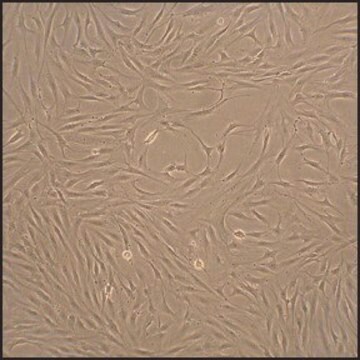About This Item
Polecane produkty
pochodzenie biologiczne
human articular cartilage
Poziom jakości
opakowanie
pkg of 500,000 cells
producent / nazwa handlowa
Cell Applications, Inc
tryb wzrostu
Adherent
kariotyp
2n = 46
morfologia
chondrocyte
metody
cell culture | mammalian: suitable
powiązane choroby
arthritis
Warunki transportu
dry ice
temp. przechowywania
−196°C
Opis ogólny
Ludzkie chondrocyty, HC, pochodzą z normalnej ludzkiej chrząstki stawowej, gdzie wytwarzają i utrzymują macierz zewnątrzkomórkową chrząstki, w tym kolagen typu II. Chondrocyty hodowane w hodowli jednowarstwowej na stałej powierzchni mają tendencję do utraty swoich markerów fenotypowych i stają się zdezróżnicowane do fenotypu podobnego do fibroblastów. Ten etap dezróżnicowania można odwrócić, hodując je w półstałym żelu.
Normalne chondrocyty uzyskane z Cell Applications, Inc. zostały zaadaptowane jako system modelowy in vitro w wielu badaniach poszukujących mechanizmów komórkowych, takich jak kaskady sygnalizacyjne związane ze stanem zapalnym, nieprawidłowa produkcja proteinaz, apoptoza i różnicowanie chondrocytów, a także nowe potencjalne metody leczenia chorób stawów.
Charakterystyka: Pozytywne dla agrekanu po różnicowaniu.
Normalne ludzkie chondrocyty (HC) zostały użyte do:
- Opracowania wysokoprzepustowego testu do przesiewania genów zdolnych do indukowania fenotypu podobnego do OA w chondrocytach w celu zidentyfikowania kluczowych szlaków związanych z chorobą (Daouti, 2005).
- Wyjaśnienie kaskady sygnałowej prowadzącej do indukcji cytokin prozapalnych przez chondrocyty w stawach RZS (Aida, 2006; Wang, 2011a,b) oraz wpływu podwyższonej sygnalizacji IL-6 na normalne chondrocyty (Namba, 2007).
- Zbadać mechanizmy i zidentyfikować inhibitory zwiększonej produkcji proteinaz przez chondrocyty stymulowane przez interleukinę-1 (Aida, 2005; Wada, 2006), kwas retinowy (Hikichi, 2009), cytokiny prozapalne (Tanigawa, 2011a,b), tlenek azotu (Wu, 2007; Yang, 2011) i naprężenia ścinające (Wang, 2011b, 2012);
- Zbadanie przyczyn indukcji metaloproteinaz u pacjentów z zapaleniem stawów związanym z boreliozą (Lin, 2001; Behera, 2004, 2005).
- Badanie czynników wpływających na apoptozę chondrocytów (Cherng, 2008; Malemud, 2012) i różnicowanie w osteoklasty (Watanabe, 2009a,b; Honda, 2011).
- Wykazać, że hialuronian (HA) może zapobiegać nasilonej degradacji chrząstki poprzez blokowanie produkcji metaloproteinaz macierzy z chondrocytów aktywowanych cytokinami poprzez indukcję MKP-1 poprzez sygnalizację CD44 (Hashizume, 2009, 2010).
- Wykazanie cytotoksycznego działania przeciwciała monoklonalnego ARG098 przeciwko ludzkiemu Fas/APO-1/CD95 (Fas) na synowiocyty RZS i naciekające limfocyty, ale nie na prawidłowe chondrocyty (Tamburstuen, 2010).
Normalne chondrocyty zostały również wykorzystane w funkcjonalnym teście agarozowym tworzenia klastrów, który pozwala chondrocytom na utrzymanie ich zróżnicowanego stanu (Quintavalla, 2005) oraz do badania szlaków mechanotransdukcji za pośrednictwem integryn, wymaganych do prawidłowego funkcjonowania chondrocytów (Whitney, 2012). Ponadto były one szeroko stosowane w badaniach materiałowych mających na celu poprawę adhezji chondrocytów do implantów medycznych (Gutwein, 2002; Ellison, 2003; Price, 2004; Savaiano, 2004; Burns, 2009) i rusztowań do regeneracji chrząstki (Jun, 2002; Kay, 2002; Miller, 2002a,b; Price, 2002, 2003; Rao, 2004; Park, 2005; Khang, 2008). Normalny RNA chondrocytów został wykorzystany jako złoty standard kontrolny w badaniach nad przeprogramowaniem komórek w chondrocyty (Ishii, 2012).
Pochodzenie linii komórkowej
Zastosowanie
Komponenty
Uwaga dotycząca przygotowania
- 2. pasaż, >500 000 komórek w pożywce podstawowej zawierającej 10% FBS i 10% DMSO
- Może być hodowany przez co najmniej 10 podwojeń
Rutyna subkultury
Oświadczenie o zrzeczeniu się odpowiedzialności
Kod klasy składowania
11 - Combustible Solids
Klasa zagrożenia wodnego (WGK)
WGK 1
Temperatura zapłonu (°F)
Not applicable
Temperatura zapłonu (°C)
Not applicable
Wybierz jedną z najnowszych wersji:
Certyfikaty analizy (CoA)
It looks like we've run into a problem, but you can still download Certificates of Analysis from our Dokumenty section.
Proszę o kontakt, jeśli potrzebna jest pomoc Obsługa Klienta
Masz już ten produkt?
Dokumenty związane z niedawno zakupionymi produktami zostały zamieszczone w Bibliotece dokumentów.
Klienci oglądali również te produkty
Protokoły
Środki ostrożności dotyczące obchodzenia się z krioelementami zapobiegają obrażeniom spowodowanym wybuchami ciekłego azotu.
Store the cryovials in a liquid nitrogen storage tank immediately upon arrival.
Nasz zespół naukowców ma doświadczenie we wszystkich obszarach badań, w tym w naukach przyrodniczych, materiałoznawstwie, syntezie chemicznej, chromatografii, analityce i wielu innych dziedzinach.
Skontaktuj się z zespołem ds. pomocy technicznej










